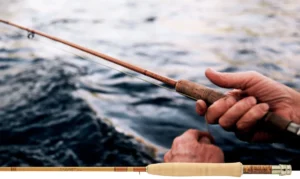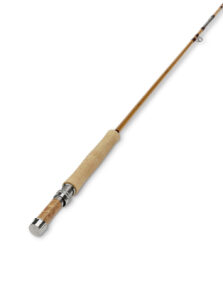
Article-At-A-Glance
-
Silk and nylon are the two primary choices for wrapping threads, each with unique benefits.
-
Wrapping threads contribute to the overall strength, durability, and aesthetic appeal of bamboo fly rods.
-
Choosing the right color and style of thread can personalize and enhance the beauty of the rod.
-
Proper wrapping technique is crucial for the functionality and longevity of the rod.
-
Maintenance and repair of wrapping threads are essential to preserve the rod’s performance over time.
Wrapping Thread for Bamboo Fly Rods
The art of crafting bamboo fly rods is a time-honored tradition that blends the elegance of the past with the precision of modern angling. Every detail matters, from selecting the right bamboo to the final finish. But let’s zero in on one critical aspect: the wrapping thread. It’s the unsung hero that holds everything together—quite literally.
The choice of thread not only affects the rod’s performance but also its overall charm. A well-wrapped rod is a sight to behold and a pleasure to fish with. So let’s dive into the world of wrapping threads and discover how to select the best one for your bamboo fly rod.
Tradition Meets Modern Fly Fishing
When it comes to bamboo fly rods, tradition is not just about aesthetics; it’s about performance. For generations, anglers have relied on the resilience of bamboo and the craftsmanship that goes into each rod. The wrapping thread plays a pivotal role in this, as it secures the guides through which the fishing line runs.
If you are repairing or restoring a vintage antique, or even building a replica or reproduction of a classic, then you’ll likely want to use silk thread to attain or reproduce that antique look.
Functionality of Wrapping Threads
The thread must be strong enough to withstand the tension and friction that come with casting and reeling in fish. But it also needs to be flexible enough to allow the bamboo’s natural action to shine through. This is where the type of thread you choose becomes crucial.
Selecting Your Wrapping Thread
When you’re standing in the aisle of your local fly shop or browsing online, the choice between silk and nylon might seem overwhelming. Here’s what you need to know: silk is the traditionalist’s choice, prized for its natural sheen and the way it can be made nearly invisible under a coat of varnish. Nylon, on the other hand, is known for its durability and vibrant colors that don’t fade over time.
Comparing Silk and Nylon
|
Silk |
Nylon |
|---|---|
|
Natural fiber with a classic look |
Synthetic and highly durable |
|
Requires more care and maintenance |
Resistant to UV rays and water damage |
|
Less visible under finish |
Available in a wider range of colors |
Strength, Durability, and Aesthetic Appeal
Most importantly, you want a thread that won’t let you down when you’ve hooked the catch of a lifetime. That’s why strength and durability are key. Silk threads, while they require more attention, offer a classic and traditional appeal that many rod builders swear by. Nylon threads, being tougher, might not need replacing as often, making them a practical choice for many anglers.
Because the look of your rod is also important, you’ll want to consider the aesthetic appeal. Silk threads, once varnished, take on a beautiful, translucent quality that many find irresistible. Nylon threads can provide a pop of color that stands out against the natural bamboo.

Color and Style Choices in Wrapping
Choosing the right color and style for your wrapping thread can be just as important as the technical aspects. The thread color should complement the natural tones of the bamboo and reflect your personal style. Whether you prefer the classic look of a transparent silk wrap or the bold statement of a brightly colored nylon, the choice is yours.
Now, armed with the knowledge of the best wrapping threads and techniques, you’re ready to build, repair, or restore your bamboo fly rod. Remember, the best thread is the one that meets your needs for strength, durability, and aesthetics. Whether you choose silk for its traditional elegance or nylon for its robustness, the care and attention you put into wrapping will reflect in the performance and beauty of your rod.
Personalizing Your Fly Rod
Now, let’s talk about personalizing your bamboo fly rod with the right color and style of wrapping thread. This is where your creativity can shine. The color of the thread is more than just an aesthetic choice; it reflects your personality and the spirit of the rod you’ve crafted or restored. Here are some pointers to help you choose the perfect thread color:
-
Consider the natural hue of the bamboo: Select a thread color that harmonizes with the warm tones of the cane. Earthy colors like browns and greens often complement bamboo well.
-
Think about visibility: Some anglers prefer a thread color that stands out for easier guide visibility, especially in low light conditions.
-
Tradition vs. modernity: Traditionalists might lean towards subtle, natural colors, while others may opt for bold and bright hues that make a statement.
Regardless of the color you choose, ensure that the thread is of high quality and suitable for the demands of fly fishing. After all, the best wrapping thread is one that not only looks good but also performs exceptionally.
Wrapping Techniques Step-by-Step
Before we get our hands on the threads, let’s set the stage for success. Preparing the cane involves ensuring it’s clean, straight, and ready for wrapping. Once that’s done, you’ll want to gather your materials: the thread of your choice, a sharp pair of scissors, and a steady hand.
Wrapping a bamboo fly rod is a meditative process, one that requires patience and precision. You’ll start by securing the thread with a few tight wraps, then continue by laying each successive turn neatly beside the last. This is where the magic happens—watch as the thread transforms into a seamless band that will hold your guides in place for years to come.
Mastering the art of wrapping a bamboo fly rod requires an understanding of the nuances that come with each type of thread. For those new to rod building, here’s a simple breakdown:
Preparing the Cane
Before wrapping, the bamboo rod must be prepared meticulously. Ensure that the surface is smooth and free of any debris or old adhesive. This preparation is vital for the thread to adhere correctly and for the finish to look impeccable. Once the rod is prepped, you can begin the wrapping process.
Mastering Tight and Even Wraps
To achieve tight and even wraps, start by anchoring the thread with a few turns, then apply tension with your fingers as you wrap. Keep each wrap snug against the last, creating a uniform look. After wrapping the guides, secure the thread with a knot or adhesive before trimming any excess.
Remember, the key to a perfect wrap is consistency. Each turn of the thread should be just as tight as the last, preventing any gaps or bulges.
Maintenance and Repair of Wrapping Threads
Like any part of a bamboo fly rod, the wrapping threads require regular maintenance. Over time, they may become worn or damaged, which can affect the rod’s performance. Inspecting your wraps after each fishing trip can help catch any potential issues early.
Assessing Wear and Making Repairs
If you notice fraying or loose threads, it’s time for a repair. Carefully remove the damaged section and clean the area. Then, re-wrap using the same type of thread. Apply a new coat of varnish or epoxy to protect the thread and keep it secure.
Long-Term Preservation of Wrapped Joints
To ensure the longevity of your bamboo fly rod, store it properly when not in use. Keep it in a cool, dry place away from direct sunlight, which can degrade the thread over time. Additionally, applying a fresh coat of varnish or epoxy every few years can help preserve the wraps.
im

Frequently Asked Questions
What’s the Difference Between Silk and Nylon for Wrapping?
The primary difference between silk and nylon wrapping threads lies in their material properties. Silk, being a natural fiber, offers a traditional look with a subtle sheen and is less visible under a finish. Nylon, a synthetic option, provides greater durability and is available in a wider range of vibrant colors that are resistant to UV rays and water damage.
How Often Should Wrapping Threads Be Replaced?
Wrapping threads should be replaced when they show signs of wear, such as fraying or fading. For silk threads, this might be more frequent due to their delicate nature. Nylon threads, being more robust, may last longer. However, it’s good practice to inspect your wraps regularly and replace them as needed to ensure the integrity of your fly rod.
Can I Use Polyester Thread for Wrapping My Fly Rod?
While silk and nylon are the most common choices, polyester thread can also be used for wrapping fly rods. It’s strong, durable, and has a lustrous appearance. However, it’s not as traditional as silk and may not have the same classic appeal. It’s essential to use a thread that you trust for its strength and compatibility with the finish you’re applying.
How Do I Choose the Right Thread Color for My Bamboo Fly Rod?
Choosing the right thread color for your bamboo fly rod is a blend of personal preference and practicality. Consider the environment where you’ll be fishing, the visibility of the thread under various lighting conditions, and how the color complements the bamboo. It’s also worth thinking about the statement you want to make with your rod – whether it’s a nod to tradition or a burst of modern flair.
What Are the Best Practices for Wrapping Bamboo Fly Rods?
The best practices for wrapping bamboo fly rods include selecting a high-quality thread, preparing the rod surface properly, and applying consistent tension during the wrapping process. Ensure each wrap is snug and even, and finish with a protective coat of varnish or epoxy. Regular maintenance and proper storage will keep your wraps – and your rod – in top condition.





